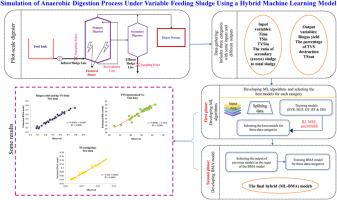利用混合机器学习模型模拟不同进料污泥条件下厌氧消化过程
IF 8.1
2区 环境科学与生态学
Q1 ENVIRONMENTAL SCIENCES
引用次数: 0
摘要
厌氧消化(AD)是稳定污水处理厂污泥的关键方法。随着人工智能的进步,本研究研究了一种混合方法,利用实验室规模设置的数据来模拟AD系统的性能。采用决策树(DT)、随机森林(RF)、梯度增强(GB)、支持向量回归(SVR)和多层感知器(MLP)五种机器学习(ML)技术,根据不同的输入污泥条件,估计沼气池的沼气产量、挥发性固体去除率和总固体产量。采用决定系数(R2)、均方误差(MSE)和平均绝对相对误差(MARE)评价模型的性能。结果表明,输入数据与输出参数之间存在较强的相关性,最佳沼气输出模型的R2为0.90,MSE为0.001,MARE为5.83%。相比之下,总固体产量表现最差,R2为0.53,MSE为0.0005,MARE为31.46%。为了提高预测精度,将贝叶斯模型平均与ML模型结果相结合。该方法显著改善了评价指标,将R2从0.53提高到0.98,将MSE和MARE分别降低到0.0000和4.73%。本文章由计算机程序翻译,如有差异,请以英文原文为准。

Simulation of anaerobic digestion process under variable feeding sludge using a hybrid machine learning model
Anaerobic digestion (AD) is a key method for stabilizing sludge in wastewater treatment plants. With advancements in artificial intelligence, this study investigates a hybrid approach to simulate the performance of AD systems using data from a laboratory-scale setup. Five machine learning (ML) techniques—decision tree (DT), random forest (RF), gradient boosting (GB), support vector regression (SVR), and multilayer perceptron (MLP)—were employed to estimate biogas production, the volatile solids removal, and the total solids output of the digester based on varying input sludge conditions. Model performance was evaluated using the coefficient of determination (R2), mean squared error (MSE), and mean absolute relative error (MARE). The results showed strong correlations between input data and output parameters, with the best model for biogas output achieving an R2 of 0.90, MSE of 0.001, and MARE of 5.83 %. In contrast, the lowest performance was observed for total solids output, with an R2 of 0.53, MSE of 0.0005, and MARE of 31.46 %. To enhance prediction accuracy, Bayesian model averaging was applied to combine with the results of ML models. This hybrid approach significantly improved the evaluation metrics, increasing the R2 from 0.53 to 0.98 and reducing the MSE and MARE to 0.0000 and 4.73 %, respectively.
求助全文
通过发布文献求助,成功后即可免费获取论文全文。
去求助
来源期刊

Chemosphere
环境科学-环境科学
CiteScore
15.80
自引率
8.00%
发文量
4975
审稿时长
3.4 months
期刊介绍:
Chemosphere, being an international multidisciplinary journal, is dedicated to publishing original communications and review articles on chemicals in the environment. The scope covers a wide range of topics, including the identification, quantification, behavior, fate, toxicology, treatment, and remediation of chemicals in the bio-, hydro-, litho-, and atmosphere, ensuring the broad dissemination of research in this field.
 求助内容:
求助内容: 应助结果提醒方式:
应助结果提醒方式:


